Granite
Category: Plutonic
Type Porphyric biotite granite – the Liberec granite, Krkonoše-Jizera Massif.
Commons Granite is a plutonic rock composed dominantly by quartz, alkalic feldspar and plagioclase in various proportions, biotite and/or hornblend.
Name origin Origin of the name is unclear. The name appeared for the first time in works of the English botanists, physician and philosopher Caesalpinus in the 16th century.
Locality Ruprechtice – Lednice (district Liberec), Czech republic
GPS: 50° 47' 24" N, 15° 4' 2.999" E
Major minerals Orthoclase, quartz, biotite, muscovite and plagioclase, which is twinned according to the albite law and oscillatory zoned. Chemical composition of the core corresponds to oligoclase and andesine (An30-38), whereas more acidic oligoclase and andesine occur in the margin.
Accessory minerals Zircon and apatite, mainly as inclusions in biotite, titanite, orthite, magnetite, pyrite.
Classification In the upper part of QAPF classification of plutonic rocks (Streckeisen, 1976), the granite field is defined by the modal composition of quartz (Q 20 – 60 %) and the P/(P + A) ratio between 10 and 65. The granite field comprises two sub-fields: syenogranite and monzogranite. Only rocks projecting within the syenogranite are considered granites in the Anglo-Saxon literature. In the European literature, rocks projecting within both syenogranite and monzogranite are named granites. The monzogranite sub-field contained adamellite and quartz monzonite in older classifications. The Subcommission for Rock Cassification recommends most recently rejecting the term adamellite and to name as the quartz monzonite only the rocks projecting within the quartz monzonite field sensu stricto.
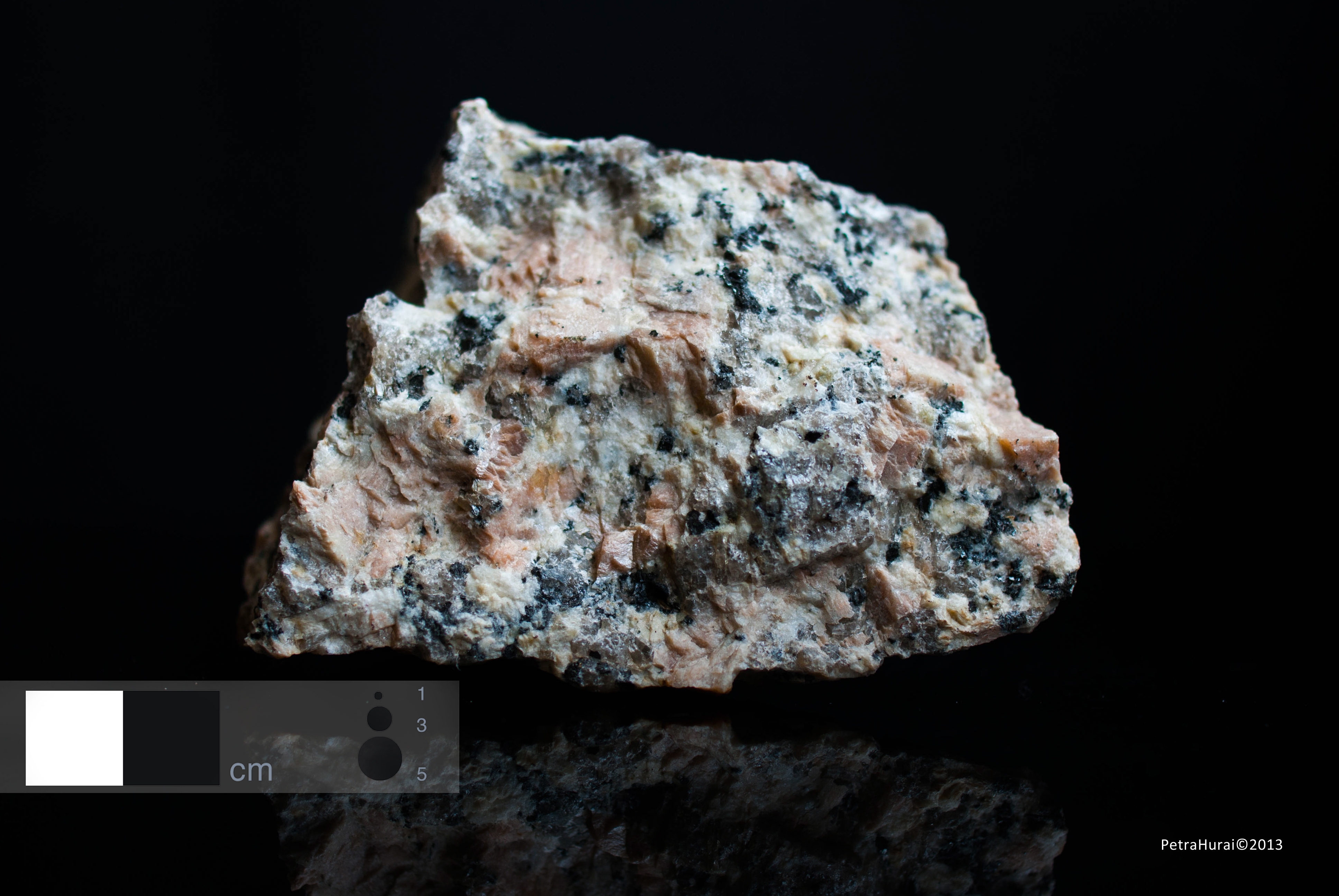
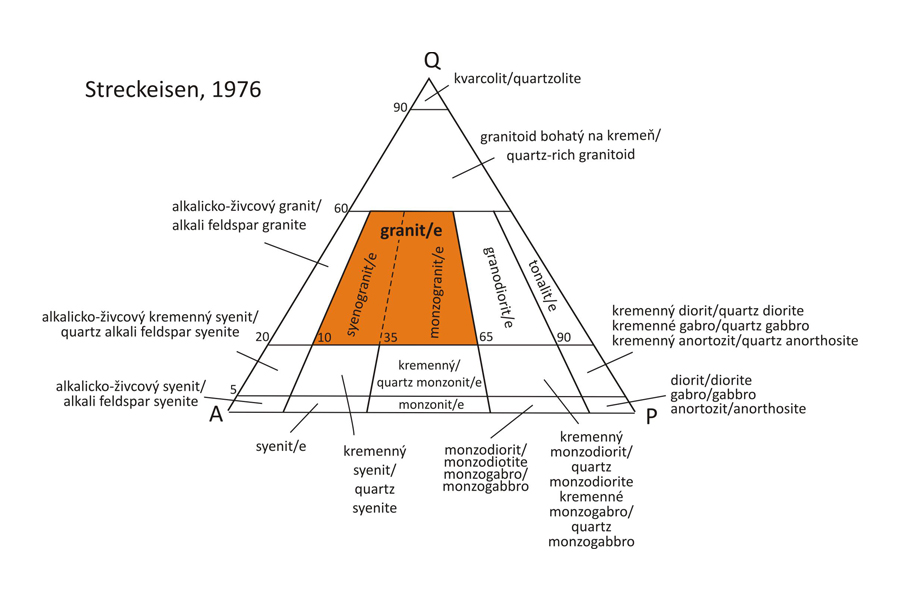
Colour Pink-grey.
Structure Massive, confining.
Granularity Coarse-grained (3 mm – 1 cm) to very coarse-grained (>1 cm) rock.
Texture Faneritic, holocrystalline, pan-hypidiomorphically grained, porphyric in places.
Alterations The rock is unaltered, feldspars are rarely sericitized.
Petrographic characteristics Coarse-grained to very coarse-grained felsic rock composed of phenocrysts of short columnar, pinky to light red K-feldspars (up to 3 cm in size), grey quartz and dark biotite. K-feldspar (orthoclase) are often twinned according to the Carlsbad law. The rock is homogeneous, only rarely inclusions occur.
Usage The Liberec granite is trademark. It belongs to the most decorative Bohemian facing stones. Coarse-grained variety is designated as the Jizera granite.
Literature Klomínský J., 1969: Krkonošsko-jizerský granitoidní masiv. - Sbor. Geol. věd, řada Geologie, 15, 7-132. Klomínský, J., (Ed) 2004: Základní geologická mapa České republiky 1 : 25 000 s Vysvětlivkami, 03-323 Jablonec n. Nisou, Česká geologická služba, Praha, 62 s. Klomínský, J., Schovánek, P., Jarchovský, T., Sulovský, P., Toužímský, M., 2006: Kontakt tanvaldského a libereckého granitu u Jablonce nad Nisou, Zprávy o geologických výzkumech v roce 2006, Česká geologická služba, 24 - 29. Rybařík V., 1994: Ušlechtilé stavební a sochařské kameny České republiky. Nadace střední průmyslové školy kamenické a sochařské v Hořicích v Podkrkonoší.
Photomicrographs
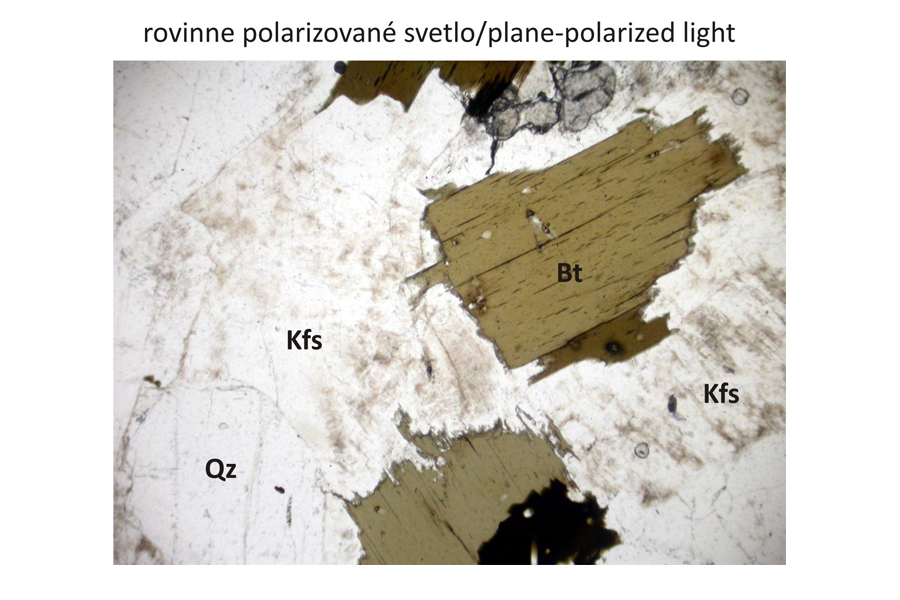
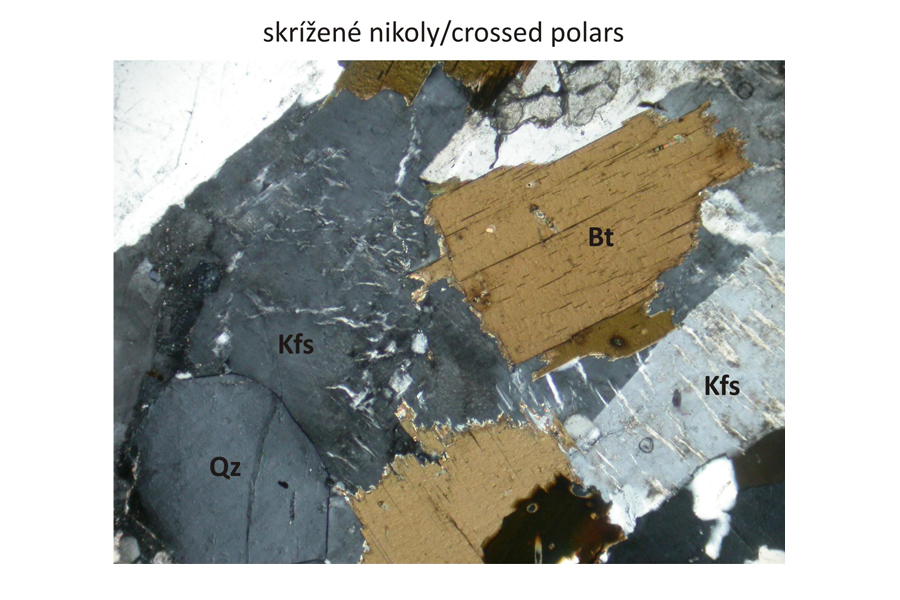
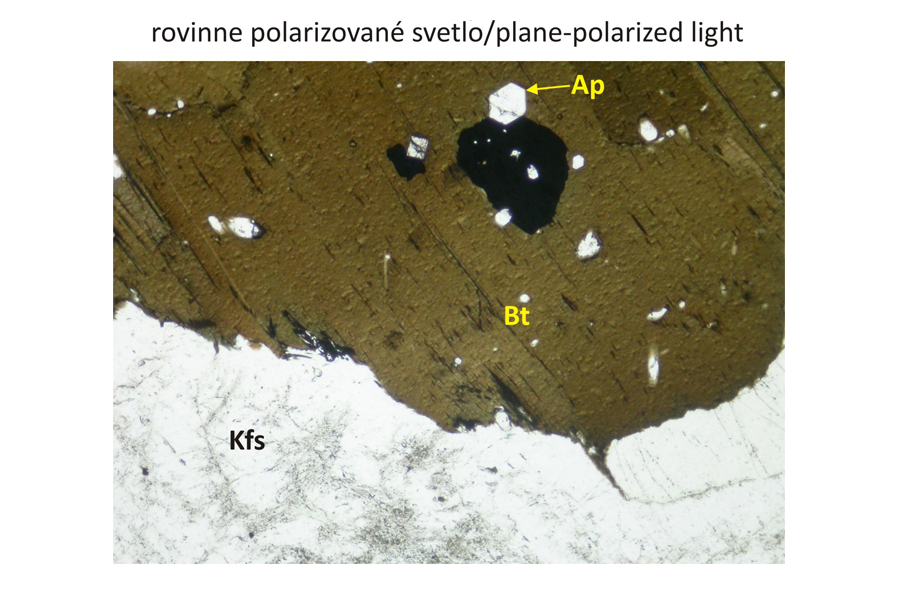

Large phenocrysts of biotite – Bt and orthoclase – Kfs alongside quartz – Qz. Distinctive twinning according to the Carlsbad law is discernible on the right side in orthoclase (upper photomocrographs). Cross-section of euhedral apatite – Ap is seen enclosed in the biotite – Bt (lower photomicrographs). The apatite is in extict position in crossed polars, because the cut is perpendicular to c-axis and the apatite has a hexagonal symmetry. Width of all photomicrographs corresponds to 2.2 mm.
Normative composition
Granite is a quartz-saturated rock. It contains normative quartz – q and hypersthene – hy. The content of normative corundum – c around 1 wt. % distinguishes the granite from tonalite or diorite. As a rule, the content of normative corundum is lower (up to 0.5 wt. %) in granodiorite.
Normative minerals
SiO2
TiO2
ZrO2
Al2O3
Fe2O3
FeO
MnO
MgO
CaO
Na2O
K2O
P2O5
F
S
CO2
Total
Molar proportion of normative mineral
Molecular mass of normative mineral
Weight % of normative mineral
Oxide
(wt. %)
71.27
0.37
14.32
0.71
1.70
0.06
0.76
1.85
3.42
4.05
0.14
98.65
Molecular
weight
60.08
79.88
101.96
159.69
71.85
70.94
40.31
56.08
61.98
94.20
141.95
Molecular
proportion
1.1862
0.0046
0.1405
0.0044
0.0244
0.0008
0.0189
0.0330
0.0552
0.0430
0.0010
ap
0.0033
0.0010
0.0010
328.68
0.32
il
0.0046
0.0046
0.0046
151.75
0.70
or
0.2580
0.0430
0.0430
0.0430
556.67
23.93
ab
0.3311
0.0552
0.0552
0.0552
524.46
28.94
an
0.0594
0.0297
0.0297
0.0297
278.21
8.26
c
0.0126
0.0126
101.96
1.28
mt
0.0044
0.0044
0.0044
231.54
1.03
zvyšky
0.0154
0.0189
hy
0.0343
0.0154
0.0189
0.0343
114.58
3.93
q
0.5035
0.5035
60.08
30.25
D: -0.5035
Mg/(Mg+Fe2+): 0.550
Total of normative wt. % 98.65
Comment The Al2O3 excess after creation of the normative orthoclase - or, albite - ab and anorthite - an is manifested by the presence of normative corundum - c.
Chemical composition
The Liberec granite is peraluminous rock with molecular Al2O3/(CaO + Na2O + K2O) ratio = 1.07 and the molecular Al2O3 /(Na2O + K2O) ratio = 1.43. The rock is rich in rare trace elements, such as Li (200 ppm), Rb (194 ppm), Ba (582 ppm) and Sr (144 pp). It is also typical of an increased F content up to 0.1 wt. %.
-
SiO2
71.27TiO2
0.37Al2O3
14.32Fe2O3
0.71FeO
1.70MnO
0.06MgO
0.76CaO
1.85Na2O
3.42K2O
4.05P2O5
0.14Total
98.65Mg(Mg/Fe2+)
0.44A/CNK
1.07A/NK
1.43
Klomínský et al., 2006.


